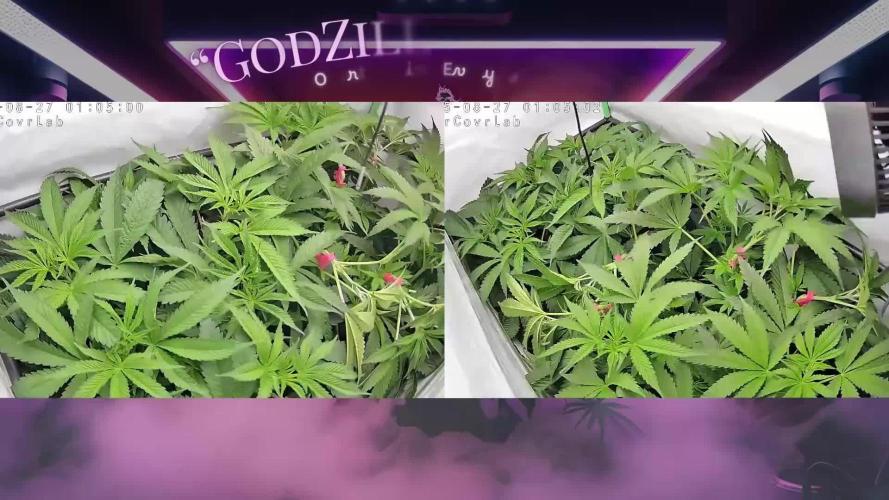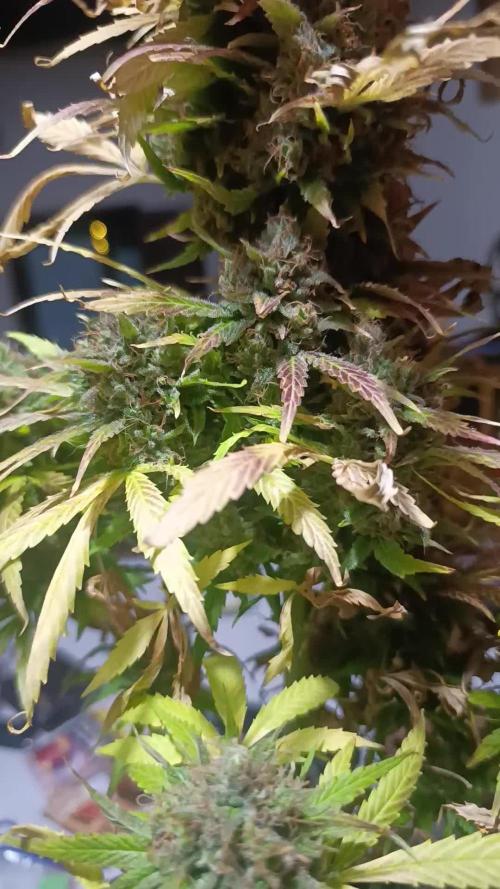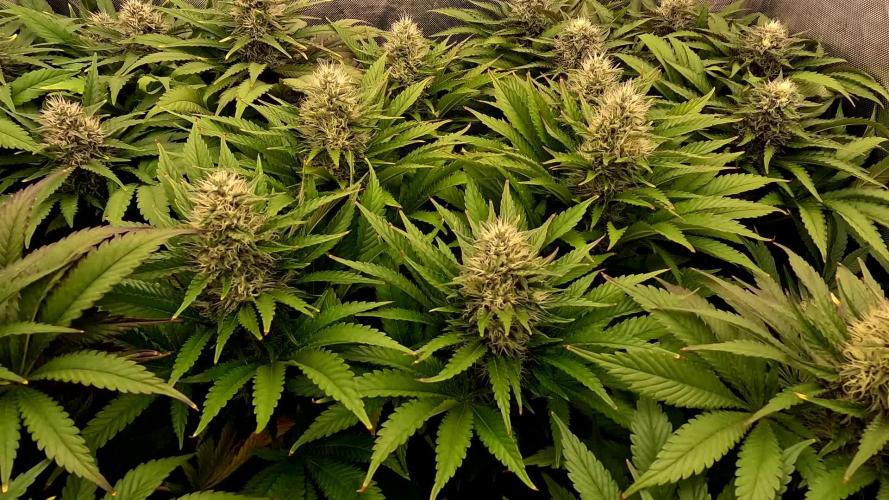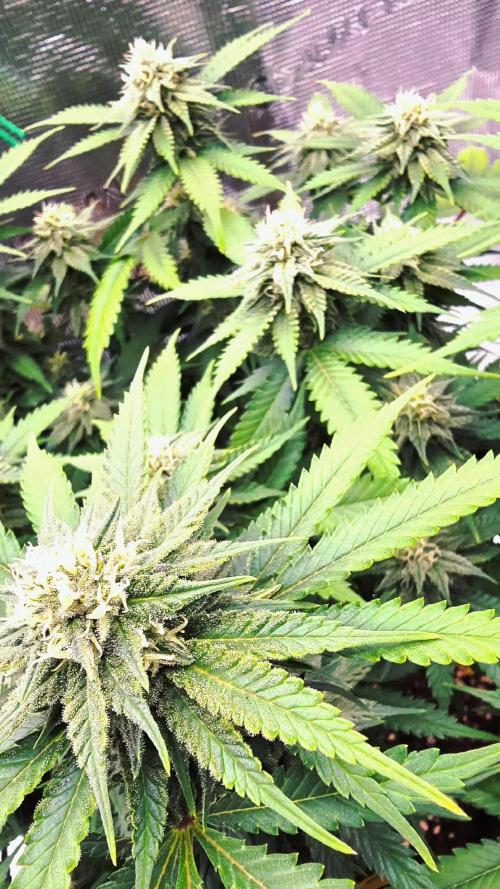The Grow Awards 2026 🏆 



























Likes
Comments
Share


@AlpenZilla
Follow
🗓️ Week 6 – Flower Week 2 (MAC n Cheese only)
MAC n Cheese is progressing very well into the second week of flower. No signs of stress or deficiencies – just healthy, steady development. 🌱
💧 Watering & Feeding:
• 6 L every 3 days
• Input EC: 1.3
• Drain EC: 0.92
→ Nutrient uptake looks balanced and clean – no issues visible.
🍃 Feeding is still based on ~50 % of the Advanced Nutrients schedule, but since the plant is clearly pulling more now, the next watering will increase to 75 %.
📏 Current height: 74 cm
Stretch is still ongoing but appears to be slowing down slightly.
Everything’s looking smooth for now. More updates soon!
Likes
28
Share


@MadeInGermany
Follow
Flowering day 18
since time change
to 12 / 12 h
Hey guys :-)
The ladies have recovered well from the cold thanks to the heating mat and have developed beautifully 👍.
During the check today I saw that despite spraying neem oil 3 times, there are still a few trips :-( .
Now I've ordered nematodes again specifically against trips for leaf and substrate.
I will use that immediately 👍.
Watering was done twice this week, each time with 1.3 l (nutrients see table above)
Next week I will remove the lowermost shoots so that the energy goes into the upper buds.
Fresh osmosis water was mixed with tap water and put into the 100 liter tank so that the water can stand and I'll have enough next week :-)
Otherwise everything was cleaned.
Have fun and stay healthy 💚🙏🏻
👇🏼👇🏼👇🏼👇🏼👇🏼👇🏼👇🏼👇🏼👇🏼👇🏼👇🏼👇🏼
You can buy this Nutrients at :
https://greenbuzzliquids.com/en/shop/
With the discount code: Made_in_Germany you get a discount of 15% on all products from an order value of 100 euros.
👇🏼👇🏼👇🏼👇🏼👇🏼👇🏼👇🏼👇🏼👇🏼👇🏼👇🏼👇🏼
Water 💧 💧💧
Osmosis water mixed with normal water (24 hours stale that the chlorine evaporates) to 0.2 EC. Add Cal / Mag to 0.4 Ec Ph with Organic Ph - to 5.8 - 6.4
MadeInGermany
Likes
7
Share


@Silvadragon
Follow
Hello all hope you friends and pets are staying cool. Cassie it is around 100 degree lately and plants and herbs are dying and drying out😢. I’m luck my tree are doing very well. I just give them a dose of 1,3,3 of organic tea with good old fashion unsulpher molasses water. The buds are coming out thick and it smell good. Lucky in my state it legalized for cultivation. Hopefully it rain this week as I’ve got a vegetable garden. The lawns are dried up and droughts in many places. Sad time we live me. Everything is so expensive thst why I’ve stated a vegetable 🥦 food is expensive.
Processing
Likes
26
Share


@OutForReal
Follow
She's doing well so far. I gave her another tps of Bat guano to increase the grow during stetching stage. I also switch my 7L pot to a 13L one. Next week she's gonna get only daylight so 11/12h a day in my area.
The rain is falling every 3 days so when she's out she get an extra watering
Likes
23
Share


@adam_pawloski87
Follow
This grow was pretty simple ! They went a total of 103 days from seed! Very trichomy dense buds with the smell of Berries vanilla and skunk ! This is a must try for you all Fastbuds has the greats!!!
Likes
37
Share


@AestheticGenetix
Follow
Will update more. Easy grow super easy to maintain once I figured out my environment. They like to chunk up nicely. Definitely top and train outwards, it makes a huge difference in the plants.
7/19/24 a month after cure. i didnt do anything special or baby the curing process. these are thick and chunky feeling. breaking up a nug and i noticed the texture was different and the buds were so sticky that they kept sticking to my finger. they werent that sticky 2 weeks
Likes
83
Share


@MrJones
Follow
These ladies were heavy yielding - just wish the PK booster did not stunt them, I feel they could have even been larger, the buds are sweet and sticky, they smell amazing, they are hard and resinous - they have a beautiful mix of dark and light shades of green with bright orange hairs, very pretty, my friends are already in love with this weed, hits you like a Sativa and as the high lingers mellows like an Indica, I can't, wait to grow this again! The is an urban legend that occasionally a purple strain emerges, and when it does the outcome is legendary, just another reason to try this strain!
Likes
65
Share


@TheBudWhisperer
Follow
Week 5 of flower and seed production for all these plants has started in earnest. We cleaned up the tent somewhat and took down all the males after having done their job. Alls left is to wait for finish now.
The nute deficiency appears to have corrected itself now that we’ve balanced out the ratios a little more. The WPM is no match for the sodium bicarbonate but still gonna have to keep on top of that to the end of the grow. Full fumigation of the grow spaces will be required - multi-day process I am not looking forward to. Time cleaning is time not growing, sadly.
We’re coasting to the finish now but should still have some decent updates on our super secret seed harvesting method once they’ve fully matured😉👍. Hope everyone’s well and grow’n that straight 🔥.
Background
Fingers crossed that these Spicy Bitch regs provide at least one male so that we can back build some stock of it. In the event that does take place we’ve got a single clone of each strain from the previous pollen chuck to sit in the tent with them so they can make babies for the next few months. The whole point of the last year was to start making some foundational genetics for a third generational cross we could call our own. If you’ve been following along than you’ll know that it’s been anything but easy. Our previous pollen picks didn’t pan out at all so we’re back to the drawing board with a new option from ExoticSeeds.
This’ll be a 10 plant run with 5 regs and 6 strains for pollination including the strain itself.
We’re running in a 2x4 MarsHydro grow tent all powered by a Mars Sp6500. That’s a little more than 600w packed into half the recommended footprint😳. Why? you ask - because we like our buds big and overcompensatory😂. Really, I’m just of the mind that we can pack more light into this space than recommended and get much better results. The math doesn’t lie. At least not as long as I wasn’t high when using the calculator again…..
Many thanks to @MarsHydroLED for the opportunity to test run the equipment👊.
In addition, we’ve also moved to a new nutrient system - Druid Nutrients out of the Netherlands. They don’t really have a presence on GD yet but you’ll be hearing about them very soon I’m sure. The beauty of this system is that it’s literally a 1 (one) component system for the entirety of the plants grow cycle. It really has changed the game in terms of ease of feeding and maintenance. It’s also very versatile and seems to provide everything needed across multiple different strains in the same ratios. Keep your eyes peeled for these folks. Pretty much a guarantee that they absolutely blow up once more people know about them👍👌😎.
Strain Background
Spicy Bitch: predominantly sativa, heavy yielder with a daytime kinda trip profile. It’s a cross of Queen Mother and a Pre-2000 AK47. We’ll pull what pollen we can and hope to have a female run out a larger supply of seed for the future.
Many thanks to @Exoticseeds for the chance to give these beans a go👍👊.
Pollination Strains:
Holy Surfer S1 - this is one of the focal points for this cycle. A fellow growmie was kind enough to ship over some S1 genetics I took an interest in. The only ask back was that if I did cross it to send a few his way for testing👍. Shoutout and cheers to @blendmedmedman. Hoping to have something back to ya in short order. For full details on this alluring hybrid option check my buddies link at seedfinder -
https://en.seedfinder.eu/strain-info/Holy_Surfer/Smiling_Tiger/
Northern Lights - this came from a particularly interesting batch of seeds that have shown a very dependable variegation trait. It’s a compact and squat plant requiring very little maintenance. Typical for the strain really. It’s been chosen as an option to potentially mellow out the high , shorten the stature of the resulting hybrid and inject it with some of that mellow indica effect.
Boogie Nights - total shot in the dark. Still haven’t even tried the strain myself yet but it was available at the right time and interesting enough to make a salad with. Big thanks to AMS who’ve been nothing short of an excellent seedbank to collaborate with. Expect similar growth characteristics to that of the Northern Lights. Better resilience however.
Blueberry - this particular clone is from extremely strong stock. Spliff seeds broke the mold with this strain. She’s lower maintenance than the NL, more resilient than anything else we’ve got on the menu and the terp. Profile on this girl is out of this world. If we can bring any of these qualities to the cross, then it could be magic👌.
White Widow - garrghh, I just can’t get away from this particular plant. Again, still haven’t even tested the buds yet and all I can say is that the growth characteristics are extremely vigorous and desirable. This plant is one of 3 unicorns that I have yet to tame due to a combo of extremely bad luck and circumstance.
All told, it’s still the same story: a VERY experimental breeding project designed to shotgun a broad swath of genetics against a reliable and dependable Breeder who’s put out proven fire 🔥🤟😎👍.
Likes
9
Share


@420DeepGrow
Follow
📆 Semana 10 — Cosecha
La Mental Rainbow ha llegado a su punto ideal. Los cogollos presentan su máxima densidad, la resina brilla como un barniz natural y los pistilos ya muestran el tono final que confirma la maduración. El aroma dulce-terroso se vuelve profundo y nítido, señal clara de que la planta ha terminado de expresar todo su potencial.
🌿 Cosechada: ciclo completado con precisión, justo en su mejor momento.
¡Seguimos creciendo fuerte 💪!
Likes
24
Share


@JUNGLE_B4RNS
Follow
Week 4 of flowering
3 plants ran out of Cal. The Super Skunk are not like usual, there’s a lot of Sativa in the phenotypes. White Gorilla Haze are making small buds. Banana Kush are doing very well except the one with deficiency. Strawberry Kush are doing well except the one out of Cal. Girl Scout Cookies are doing well. Wedding Cheesecake are doing well.
Reducing the Humidity and turned on the Dehumidifier. Adding 2 small fans blowing under the canopy. Switching to bloom nutrients, feeding is between 1000ppm to 1100ppm once a week.
(I’m looking for a job in the Cannabis industry as Master Grower, Mineralogist, Quality Control)
Likes
2
Share


@gr3g4l
Follow
Semana de una más que notable transición cromática , formación de lindas porras y engorde de cogollos.
La nº6 sigue mostrando albinismo aunque parece que no aumenta de tamaño, se mantiene.
Subí los led 5ctms y parece que funcionó bastante bien.
Entramos en una fase delicada por lo que añadí un deshumidificador que se enciende cuando se apagan los led. Más adelante otro ventilador y deshumidificador las 24h. encendido.
Durante la noche con los led encendidos el ambiente es mucho mas seco que durante el dia con las luces apagadas así que el ventilador lo dejaré encendido unas horitas más durante el dia, noche para las plantas.
Hay que bajar la humedad tanto como se pueda durante esas horas en la que sube tanto.
Likes
61
Share


@Verlido
Follow
Week 11 - Day 1 : Pinched branches from subject 1 and 2. take a good look and tell me what you think!
Week 11 - Day 2 : Restday, changed water schedule to water-water-feed, watering my plants with 4 Liters per plant every 3th day.
Week 11 - Day 3 : Pinched lower branches of subject 1, take a good look and tell me what you think!
Week 11 - Day 4 : Pinches branches of subjects 2 and 3, take a good look and tell me what you think!
Week 11 - Day 5 : Pinches branches of subject 1, take a good look and tell me what you think, had my first harvest of ladybugs in the garden and released them on my plants, noticed that I have very little spider mites on my plants. Posted week 1 to 9 on my diary.
Week 11 - Day 6 : Restday, woke up to subject 5 being damaged, What could have caused this? Too heavy branches? Maybe an animal that accidentally broke the branch and took off.
Week 11 - Day 7 : Pinches branches of subject 3, take a good look and tell me what you think!
Week 12 - Day 1 : Restday, Watered my plants 4 Liters per plant with nutrients, added Big Bud.
Week 12 - Day 2 : Pinches branches of subject 1,2 and 3.
Week 12 - Day 3 : Restday.
Week 12 - Day 4 : Restday, Watered my plants 4 Liters per plant.
Week 12 - Day 5 : Supercropped subjects 1,2 and 3. In my opinion, the canopy of 1,2, and 3 were growing vertically again so I wanted to make it more even, I tied them down to 2 nodes lower after bending the mainstem in a 90-degree angle.
Week 12 - Day 6 : Unknown information
Week 12 - Day 7 : Unknown information
Likes
6
Share


@MacBrGrow
Follow
This week was very stressful, I left my girls alone because I had holidays of 11 days, got a drip system twice a day due to the heat of 37º
Likes
13
Share


@DaddyPrime
Follow
4/8 super plump and thick. Its like a square rock hard prism shaped top cola. Water intake has slowed quite a bit. The end is nearing. I give it another couple weeks
4/12 shes super pretty. Orange Pistils, dark green buds with light purple,pinkish tones on some of the bud leaves. Reminds me of the gorilla skittles online picture






























